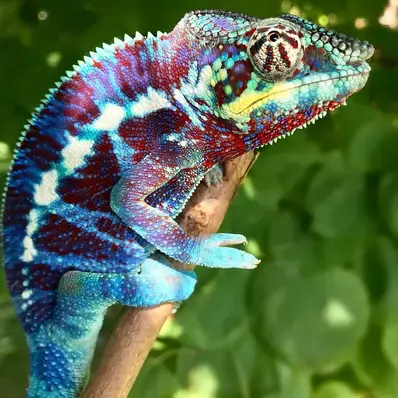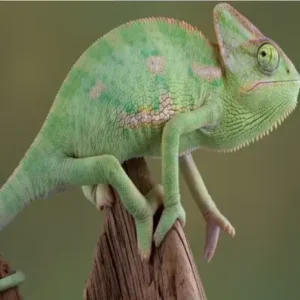History/Origin
Panther chameleons (Furcifer pardalis) have a rich history intertwined with the lush landscapes of Madagascar. Discovered and scientifically described by French naturalist Georges Cuvier in the early 19th century, they quickly captivated the attention of biologists and reptile enthusiasts alike.
Native to Madagascar, these chameleons inhabit various regions across the island, from dense rainforests to arid coastal areas. Over centuries, they have evolved unique characteristics, including their iconic color-changing ability and specialized hunting techniques, to adapt to Madagascar’s diverse ecosystems.
Revered for their beauty and intriguing behavior, Panther chameleons continue to be studied, highlighting their significance in reptile conservation.
Personality
Panther chameleons, as pets, possess unique personalities shaped by their natural instincts and environmental needs. While they are solitary creatures in the wild, captive-bred panther chameleons can adapt to human interaction to some extent. However, they often prefer to observe their surroundings from a distance rather than seek direct interaction with their owners.
As pets, panther chameleons may display a wide range of behaviors, from calm and curious to defensive and territorial. Some individuals may tolerate occasional handling, while others may become stressed or agitated by it. Understanding and respecting their boundaries is crucial for maintaining their well-being.
Physical Appearance
Let’s take a closer look at the physical appearance of panther chameleons.
- Size: Adult male panther chameleons typically range from 17 to 20 inches in length, while females are generally smaller, averaging around 10 to 14 inches.
- Color: One of the most striking features of panther chameleons is their ability to change color. They display vibrant hues of green, blue, red, and yellow, often influenced by factors like mood, temperature, and lighting.
Gender Differences
Male and female panther chameleons exhibit distinct physical differences that are readily observable:
Male Panther Chameleons
- Size: Generally larger in size compared to females, with adult males ranging from 17 to 20 inches in length.
- Coloration: Display more vibrant and varied coloration, often featuring bold patterns of green, blue, red, and yellow hues.
- Casques: Possess prominent casques, or crests, on their heads, which are used for territorial displays and attracting mates.
- Tail Length: Typically have longer tails compared to females, aiding in balance and agility during climbing and locomotion.
Female Panther Chameleons
- Size: Smaller in size compared to males, with adult females averaging around 10 to 14 inches in length.
- Coloration: While still colorful, females usually have less intense and varied coloration compared to males, with more subdued hues.
- Casques: Lack the prominent casques seen in males, with flatter heads overall.
- Tail Length: Possess shorter tails compared to males, proportional to their smaller body size.
These gender differences play significant roles in reproduction, territorial behavior, and overall physical adaptations within the species.
Feed/Nutrition
Panther chameleons require a carefully curated diet to thrive in captivity. Understanding their feeding habits and providing a nutritionally balanced menu is essential for their health and well-being.
- Insect-Based Diet: Crickets, roaches, and occasional mealworms constitute the varied diet of a Panther Chameleon, providing essential protein and nutrients.
- Nutritional Supplementation: Panther Chameleons require dusted calcium supplements and periodic reptile-specific multivitamin supplementation for balanced nutrition. They are important for maintaining bone health and preventing metabolic bone disease.
Feeding Practices
Here are the feeding practices and gut-loading techniques for panther chameleons.
- Frequency: Young panther chameleons require daily feedings, while adults can be fed every other day. Adjustments may be necessary based on the individual’s age, health, and activity level.
- Live Prey: Chameleons are stimulated by moving prey, so offering live insects promotes natural hunting behaviors.
Gut-Loading for Nutritional Value
Let’s take a look at the techniques for gut-loading insects to enhance the nutritional value for panther chameleons.
- Greens: Enhance the nutritional content of insects by gut-loading them with nutritious greens such as kale, collard greens, and dandelion leaves.
- Vegetables: Adding vegetables like carrots and squash to the insects’ diet further boosts the chameleon’s overall nutritional intake.
Health
Panther chameleons, like any reptile, are susceptible to specific health concerns. Understanding and addressing these issues promptly is critical for maintaining their well-being.
Parasites
Here’s what you need to know about parasites that can affect panther chameleons.
- Internal Parasites: Chameleons can be affected by internal parasites like nematodes and coccidia. Regular fecal examinations by a veterinarian are essential for early detection.
- External Parasites: Mites and ticks can infest the skin and scales. Regular inspections and proper husbandry practices help prevent infestations.
Kidney Failure
Inadequate hydration can lead to kidney failure. Ensuring a consistent supply of clean water and maintaining proper humidity levels in the enclosure are critical preventive measures.
Metabolic Bone Disease (MBD)
Insufficient calcium intake can result in MBD, causing weakened bones, deformities, and difficulty in movement. Proper supplementation and exposure to UVB lighting are key preventive measures.
Respiratory Infections
Poorly ventilated chameleon enclosures can lead to respiratory infections. Maintaining proper humidity levels, providing good airflow, and ensuring a clean environment minimize the risk of respiratory issues.
Stress-Related Diseases
Let’s explore stress-related diseases and factors contributing to them in panther chameleons.
Handling Stress
Excessive handling can cause stress, impacting the chameleon’s immune system. Minimize handling, and create a secure and enriched environment to reduce stress. Abnormal color changes, especially persistent dark colors, can signal stress.
Territorial Stress
Aggressive interactions between chameleons sharing an enclosure can lead to stress-related diseases. Providing separate living spaces for multiple chameleons is crucial.
Care and Grooming
Proper care for panther chameleons entails a spacious enclosure equipped with branches and foliage for climbing and hiding. Regular misting maintains humidity levels, crucial for hydration and shedding. UVB lighting provides essential vitamin D3 synthesis for bone health.
Grooming involves removing uneaten food promptly to maintain cleanliness and prevent bacterial growth. Regular enclosure cleaning prevents the buildup of harmful bacteria and parasites. Additionally, close monitoring of their health ensures early detection of any potential issues, promoting the overall well-being of pet panther chameleons.
Rescue Groups
Various reptile rescue organizations and animal shelters may occasionally have panther chameleons available for adoption. These organizations offer assistance and rehoming services for chameleons requiring care.
Here are a few mentioned:
Panther Chameleon for Sale
Panther chameleons are available for purchase from reputable breeders and pet stores specializing in reptiles. Prices vary depending on factors such as age, coloration, and lineage.
Interesting Facts
- Panther chameleons have a prehensile tail, which helps them maintain balance while climbing.
- Their tongue can extend more than twice the length of their body to capture prey.
- They possess specialized front feet with two toes facing inward and three facing outward for better grip on branches.
- Hatchling panther chameleons are born with adult colors and markings, ready to blend into their environment.
- Panther chameleons have independently moving eyes, allowing them to scan their surroundings in different directions simultaneously.
Best For
Panther chameleons are best suited for experienced reptile keepers willing to provide the specialized care and attention they require. They make fascinating display pets for enthusiasts interested in observing their unique behaviors and color-changing abilities.
Top Names
| Male Panther Chameleon Names | Female Panther Chameleon Names |
| Loki | Luna |
| Zephyr | Aurora |
| Apollo | Willow |
| Draco | Nova |
| Atlas | Cleo |
Panther Chameleon Pet Tips
Here are some essential tips for caring for a pet panther chameleon.
- Ensure the enclosure provides vertical space for climbing and hiding.
- Maintain proper humidity levels between 50-70% and temperature gradients.
- Offer a varied diet of gut-loaded insects supplemented with occasional fruits.
- Minimize handling to reduce stress; when necessary, handle gently and support the chameleon’s body.
- Provide UVB lighting to support vitamin D synthesis.
- Regularly clean the enclosure and provide fresh water.
- Monitor for signs of health issues such as respiratory infections or parasites.
- Consider consulting with a reptile veterinarian for routine check-ups and advice on optimal care practices.










